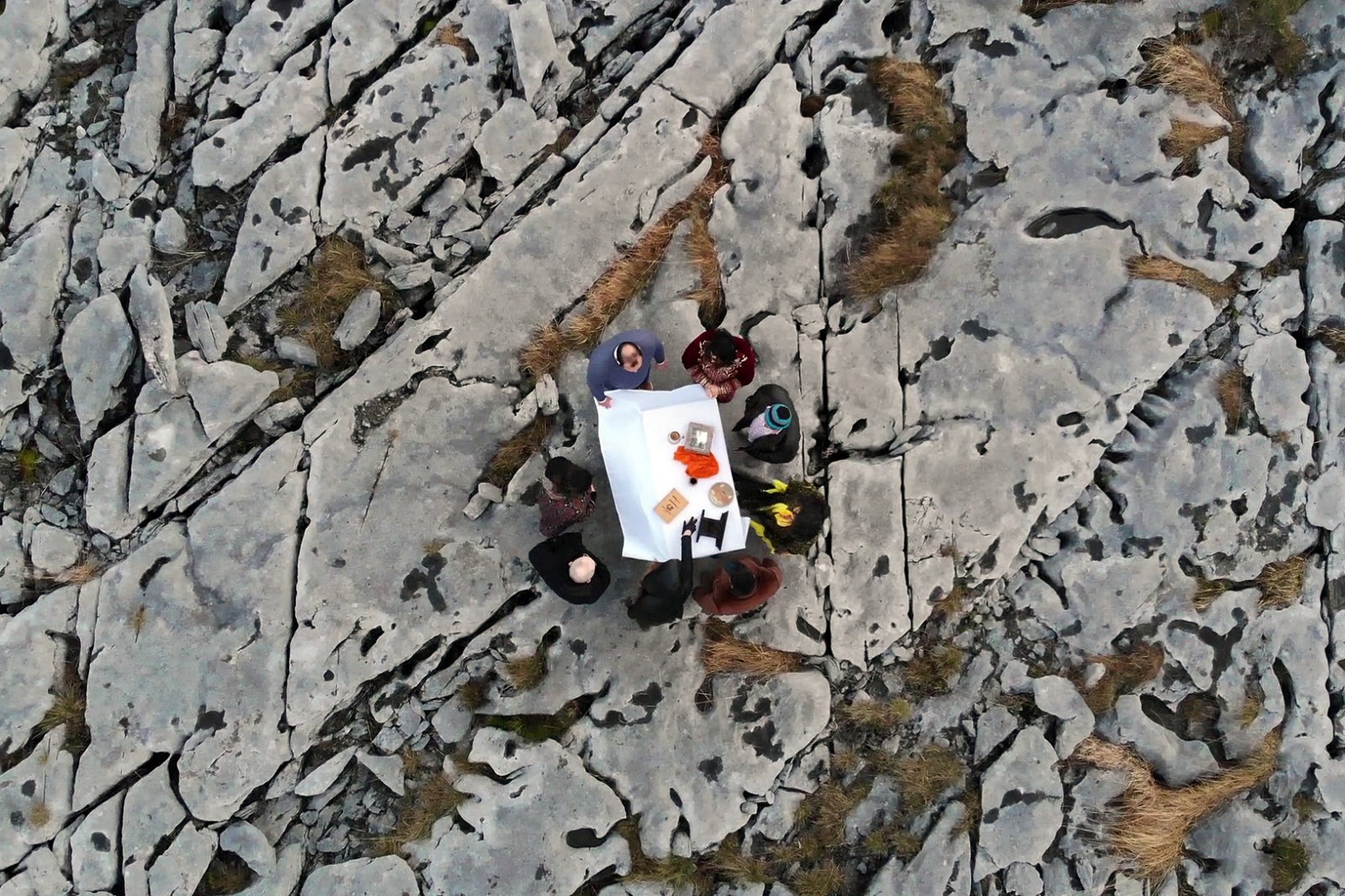IMMAxDAS Artist Spotlight with Salvatore of Lucan
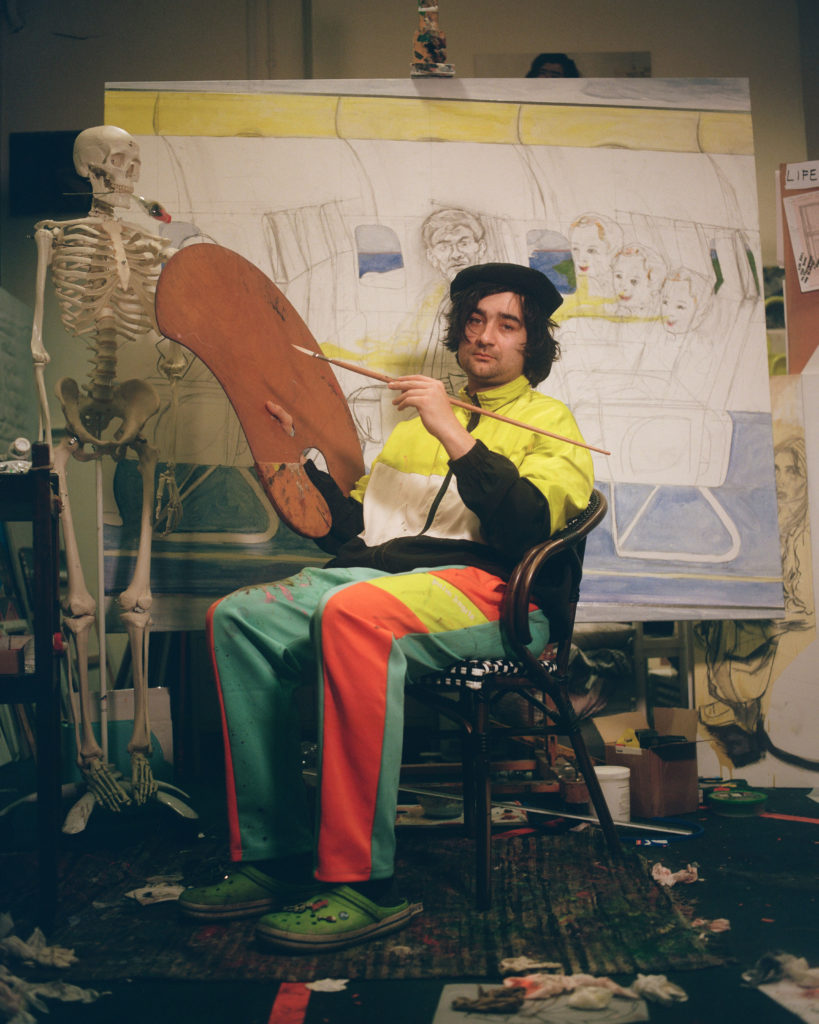
This IMMA Magazine is a transcribed interview between IMMAxDAS artist-in-residence, Salvatore of Lucan and his sister, writer Gabrielle Fullam, discussing about family, identity and painting the personal.
Salavatore of Lucan is an invited IMMA artist working in one of the four studios generously gifted to IMMA by the Dean Art Studios on Chatham Row in Dublin’s City Centre. Joining this dynamic creative community is an exciting opportunity for both the artists and for IMMA.
…………………………………………………………………………………………………………………………………………………………………………………………
Me [Gabrielle Fullam] and Sal [Salvatore of Lucan] meet in his studio in town. I am one hour late and I have picked up a Diet Coke for us both as an apology. We spend quite a while setting up the microphone because I speak much louder than him, and we don’t want the audio quality to sound poor. Despite this, the audio is quite poor. Below is a transcript of the interview.
GABRIELLE [G]: So I’m here with my brother, Salvatore of Lucan, I’m Gabrielle.
SALVATORE [S] : Of Lucan
G: Also of Lucan
S: Yeah
G: And we’re going to talk about some of your paintings of our family. A little bit about race and being ‘the other’. And about…yeah, that stuff, basically, right?
S: There was some large pauses in- when I was talking, actually, about race. We’re gonna leave that in anyway?
G: Yeah? Would you like me to?
S: Well, if this is the introduction, I would like to tell the listener that there is large pauses. I felt like there was large pauses when I was thinking of what to say.
G: [laughing] Yeah
S: [laughing] I’m just trying to make all my apologies now.
G: Yeah, you don’t need to apologise.
S: For not being particularly clear.
G: I think it’s good.
S: OK.
G: Yeah, your paintings aren’t particularly clear, either.
S: I think they’re very clear.
G: Really?
S: Yeah.
G: That’s kind of an interesting question.
S: They’re a lot clearer than I am in real life.
G: Yeah? Do you think that?
S: Yeah.
G: In what way?
S: I’m a much better painter than I am a communicator in real life. Right?
G: Yeah, that’s true.
S: Okay yeah.
G: But I wouldn’t say that those are… I wouldn’t say being a good painter doesn’t necessarily mean making a very clear painting.
S: Oh. Yeah. Well…
G: [laughing] I suppose that makes sense to you.
S: [laughing] Yeah. To me they make perfect sense. Anyway
G: Here is the interview!
………………………………………………………………………………………………………………………..
G: How are you feeling Sal?
S: Grand yeah.
G: You say that you take a little while to warm up in an interview?
S: Yeah.
G: What are you doing?
S: Getting something to fidget with, is that not allowed?
G: That is allowed.
S: Okay good, I’ll do better if I’m fidgeting.
G: Yeah, that’s good, that’s good, I just thought the mic might pick it up, so I thought it might be good to say it.
S: Oh.
G: How do you feel you normally come across in interviews?
S: Oh, good question. I usually get asked the same questions. Oh, I don’t really know how I come across though because I don’t really watch them back.
G: How do you feel about them, usually?
S: Hmm, I don’t mind them, like, I just try not to say anything that I don’t think is true. Yeah. Yeah, that’s- that’s the goal.
G: That’s the goal. Yeah. How do you feel about me interviewing you?
S: Well it was my idea.
G: Yeah, we don’t normally talk much about your work in detail and I think maybe that’s because I know, the ones I’m most interested in, I would often know the subjects in. So maybe that might make it harder, but I’m kind of most interested in the ones of our family. So we might talk about those.
S: Yeah, I’m ready.
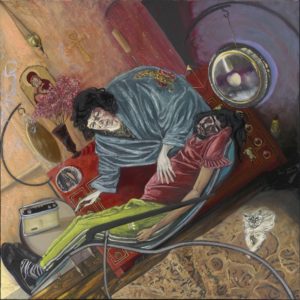
G: You’re ready. So the first one I’m interested in is Me Ma Healing Me. Why did you make that painting?
S: Em, I don’t know. I think, eh, [pause] maybe – so maybe I feel more comfortable saying this because you’re my sister, but like, I feel like the question is too hard to answer.
G: Yeah?
S: It’s too hard to answer why I paint anything really.
G: It’s a hard question. When I bring people in to see that painting, or whenever I’ve shown it to any of my friends, they are always really drawn to the kind of set in the background of it.
S: Yeah.
G: Which is kind of interesting, because most of those objects are just actual things in Mary’s room.
S: Yeah.
G: Which I think is an interesting dynamic. What do you think of that room and that set?
S: Oh, okay, yeah you’re dead right. Yeah. Like probably one of the main reasons I made that painting is because Mary’s room is quite a vista. You know, like, it’s pretty intense. [It’s] just like 16 gongs and she sleeps in a little tiny corner of it, in- on a couch. I remember when I won the Portrait Prize for that, I think Sean Kissane was like, giving a talk, or talking about why the painting won. And the whole way through the talk Mary – our mom, I call her Mary – [laughing] she was just saying “Oh, that’s mine”. Like he listed everything in the painting and she was like “That’s mine as well” [laughing], yeah we know, like it’s all of your stuff.
G: [laughing] Yeah, she is really proud of all those things.
S: Yeah she loves all those things yeah.
G: You painted it during lockdown. And you actually weren’t at home for that part of lockdown. Or maybe you had started painting it. And I remember I went in to take pictures of the carpet in her room.
S: Oh yeah true, I got you to take the photos for it.
G: Yeah, so I tell everyone that too. I go in and I say “I took the source photos” [laughing]. So, yeah, it’s a really kind of magic space, I think, that part of the house is. But you haven’t painted anything of that space before. You’re not in there that much, are you? How do you feel about it more generally? Other than, like, as the museum?
S: Em, Mary’s room?
G: Yeah.
S: How do I feel about it?
G: Yeah.
S: I think it’s kind of cool, like.
G: Yeah.
S: I think it’s definitely odd. But I like that. You know, it’s her own unique expression or own space. Or like, I suppose people say that, like, the spaces that people occupy resemble their brain.
G: Yeah. Do you feel like that about your spaces?
S: Yeah. Or like, I want it to look like my brain or something. Or like to make myself feel more comfortable or something. I don’t like- I like messy.
G: Yeah. It’s cool.
S: It’s organised a little bit as well though.
G: Yeah. You’re your cleaner that I am.
S: Definitely. You’re filthy.
G: Yeah. I’m really drawn to it because I obviously used to sleep in that room.
S: Yeah, of course, yeah.
G: Like even the corner you’re using – it’s the corner where my bed used to be. And it always had all the stuff in it. So I think, I don’t know. That’s why I’m, I’m really fascinated by the background. I don’t know, it’s obviously very religious, or something. That whole area has the sacredness to it, which I think is really nice. And she is kind of like a genie in it. Like kind of like a wisp, as well.
S: Yeah she doesn’t have legs.
G: I only realised that today, actually, when I was really looking at it.
S: Oh really
G: I was like “She doesn’t have any legs!”. So when you make those sorts of choices, obviously, one of the things you’re really interested in is the composition.
S: Yeah.
G: So how did those choices come into being? Or what kind of process do you take to do that, you know?
S: I think probably like, technically, like, when I’m composing. I start, I try and … I think composing is, like, trying to heighten all of the most important parts, or the parts that you consider the most important. So then I tried- I composed it to put the most important details in prime locations and in unison with each other. And then there was like no need for me to do her feet. It just wasn’t important. So like, like, I kind of worked out that it was going to be hard for people to even notice that there was no feet. So I just didn’t put them in. You know?
G: Yeah. That makes sense.
S: And I don’t like the idea of like, just doing them like real sketchy. I’d rather just – I’d rather do everything detailed rather than just painting something that’s not important just because it should be there.
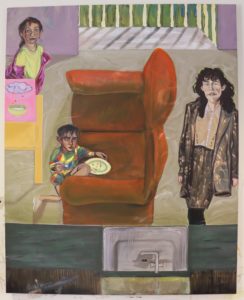
G: I think my favourite painting that you’ve done is Munich 1998.
S: Oh? Okay, no one’s really seen that. It’s never been exhibited.
G: Yeah, do you still want to talk about it?
S: Oh yeah of course, we can talk about it.
G: Well, I think Mary looks really different in that painting, than in ‘My Ma Healing Me’. She’s a lot younger. Do you have many memories from Munich?
S: I don’t really have that many memories from Munich. I have a memory of moving apartment, and being got sugary cereal, or like a sweet cereal, as a treat. But then when we got to the new apartment, there was no, eh, bowls. So I had to eat cereal out of a plate with like Mary topping up the milk and I remember being quite upset about that.
G: That’s a very funny image.
S: It’s kind of all I remember though. Like sometimes I get like a weird… I don’t know like what you’d describe it [with]. But with certain types of architecture, it makes me feel a certain way. But I don’t really know, it must be something to do with the flats we in Munich [mumbling] I’m not sure.
G: What age were you, three?
S: I think four and a half? I’m not sure, actually.
G: Yeah. That makes sense.
S: I know I spoke German when I started school here, did I?
G: Yeah. I’ve given you a hard time before about forgetting German. But that’s an interesting thing to happen. But why am I in it [Munich 1998]?
S: Well, I actually made the painting because of a request from Mary like she said, she said, like… if you were to make painting, I’d really like if you made one of when you were about seven, and Gabrielle was like two or three, or something, she said that would be, that would be a painting of like a happy memory. She would prefer that more than a painting of her now, is what she said to me. So I decided to make a painting that was kind of about, like, my vague memory from Munich, and then I added you in.
G: Thanks.
[We laugh].
G: And kind of related to that, I don’t remember what it’s called, I couldn’t find it, the family portrait in ‘Dead Present’. Family time, I think?
S: It’s called Family Time/Nanny’s Shriek
G: Yeah, and it’s also sort of related to the one [you made] before of nanny and the three uncles,
S: Yeah, the pastel drawing.
G: Yeah, so that, and I’m also thinking of the one with Nanny and Mary watching the TV and falling asleep.
S: Yep.
G: There’s quite a sense of kind of like matriarchy or motherly influence, or at least what I look at them. How do you think that relates to your work?
S: So in those two paintings… well, like, I suppose, you know, we grew up with a sort of matriarch, our grandmother and our mother. It’s not intentional, it’s not like I’m intentionally trying to make work about matriarchy, but I just make work about my own life and I grew up
G: In a matriarchal household.
S: In a matriarchal household.
G: Which I think is kind of nice… I suppose when I kind of look at them, I get, like, a very strong feeling of power in the family. I mean that a positive sense. Where I get this feeling of where a family can draw its power from. [Whether] from key figures or influences or whatever it is. Do you think that there is some level of that being a bind to the family or how do you think that that manifests visually, or otherwise?
S: I don’t think like, sorry, yeah again, like I just don’t think about it. Like I say, basically, I’m just trying to make things about how I feel, you know, and vaguely what happens in life. Yeah, so yeah, I don’t think about it. Like that’s definitely for you or a viewer to see. Especially you as well like. Yeah, yeah. A lot of paintings of the family like the main target audience probably is you, as a member of the family…. Like it’s probably made mainly for you than it is…Like, if I make it for the family and communicate something strongly to the family, then my communication is clear. And then hopefully someone else, outside the family, will understand that as well.
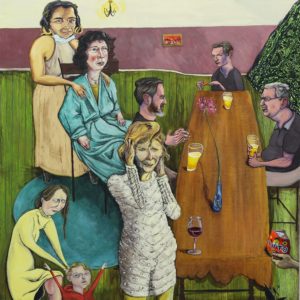
G: When you paint about very personal things, or things close to your life, or kind of from your perspective of the world… What’s it sort of like having those kinds of things exhibited or put up, and having people interact with them?
S: I suppose it’s embarrassing.
G: It’s embarrassing?
S: Probably the most, or, the main overall feeling I have when I exhibit.
G: Is embarrassed?
S: Probably yeah
G: Just because it’s- like, why?
S: Because it’s just kind of a personal isn’t it?
G: Yeah.
S: It’s embarrassing being personal.
G: Yeah, very earnest.
S: Very earnest. Well, like him at the same time, like, I mean, I feel like sometimes I get an idea and I feel like it’s embarrassing. I think it might be a good idea. Obviously there’s terrible ideas that would also be embarrassing.
G: And yeh, and when you take something or think something about something or whatever. And you put it into a painting, what’s that sort of process like internally? I know, when I start to write something, verbalising it and writing it down kind of changes how I interact with that feeling or interact with that subject. Do you feel differently about something after you painted it?
S: I think, yeah, usually, yeah, I feel a little bit better about it maybe. The painting Me and My Dad in McDonald’s. After I made that painting, I had a strong feeling that the painting hadn’t helped how I felt that situation at all, or hadn’t enlightened me at all on how I felt about that situation. But I had to keep doing like interviews and talking about it [as if it were] like I did know how I felt about the painting.
G: Yeah.
S: Because like, when you’re being interviewed, I suppose that’s one reason why I wanted you to do the interview. When you’re being interviewed, and someone asks you a question, even if it’s quite personal or if you don’t know the answer, you kind of feel like you have to give a stab, or else you’re being rude. Even though really, you don’t know. So you mean, I kind of found myself constantly talking about that painting. And like, knowing that I was like- I didn’t actually know how I felt about the painting.

G: So, did you think other people expected that you would have something profound to say about it.
S: Yeah, I had an expectation with myself to say something, yanno what I mean? I don’t even know if like, anyone else was expecting or like putting pressure on? But yeah, in general, I don’t think I think about things too much differently after I paint them. Usually I feel more or less the same. Or sometimes… I dunno actually yeah… I’m not giving a great answer here.
G: No, no, no, you’re fine.
S: Sometimes when I’m painting- I think to paint for me anyway, to sustain the effort in the painting, I need to have quite a strong feeling about the painting. To sustain it for like, long enough to like make a painting that I’d be happy with. Or like my favourite work of my own is work that I labour on or like, worked on for a long time. So if something’s- if something- if I just have a strong feeling for something, it’s easier to work on.
G: Yeah. And would that feeling be anything? Like, could it be upsetting or could it be embarrassing, or could it be happy? Like, is it just about an intense feeling or is this about a particular kind?
S: [mumbling] Em, is it an intense feeling or a particular kind… It’s- I think, more like a repetitive feeling. Like if I feel something a lot or I think about something a lot. I generally think that that’s something I should make work on. Like something that’s already going on inside my head. Rather than trying to find something outside myself and bring it into my head, to just explore the things that are already there. When trying to broach the topic of race with my brother, I deliver some incomprehensible questions and we laugh. We decide to retake after talking for a bit and relaxing.
————————————————-
G: Okay, this is take two.
S: Yeah. Gabrielle and myself have composed ourselves.
G: Yeah, we garbled it. I garbled it. Basically, what we’ve been talking about so far has kind of been about our family. But in a lot of the press and the wider context – there’s all of these other things that people- I’ve actually, garbled it. I said it [the question] just fine just before
S: Yeah, you said it fine [laughing]. It’s like you’re over explaining.
G: Yeah, I’m over explaining.
S: You just have to ask the question.
—————————————————-
G: Okay. This is take three. What we’ve been talking about so far is basically our family. And basically, what I’m wondering is, how wider social contexts and conversations on race might play into or interact with your work.
S: Yeah. So I suppose when we were talking off recording there, when we were trying to compose ourselves. I said, yeah, I suppose I don’t know how it affects or like, I don’t like to think about how it affects the work, but I suppose I know how it makes me feel. I suppose like, being mixed race and also not knowing that side of my family always contributed to like a feeling of otherness in me. Or like, that’s something that I’ve kind of, I kind of love about myself, or kind of am into or, like, I suppose I don’t [pause] I suppose the feeling of otherness always gave me like a licence to like, do whatever I wanted, or like to, like, just follow, or like not, I never felt like I had to try and fit in. I always felt like I could just do whatever I wanted, like my whole life, for some reason, or it might be that reason. Also, our mom’s quite unique as well. Like, even I felt like I was allowed to be an artist or like I was allowed to do things a little bit differently to everyone else. Because of that. But then, yeah, I suppose in terms of, like, in terms of race, like I don’t, I don’t know. Like I don’t feel Irish in lots of as well. I always make friends better with people who aren’t like, either fully Irish or didn’t grow up in Ireland. But like my work is quite Irish in lots of ways as well.
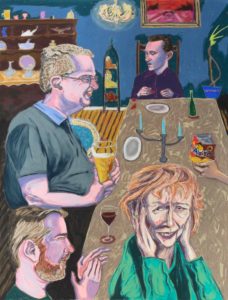
G: I suppose it’s also like Irish and Irishness is just like this huge big. I don’t know, I think of it as this huge, big concept with all this sort of social. I don’t know, baggage, for lack of a better word.
S: [hums]
G: But I don’t know. So it can be harder to kind of relate to that in a very personal way. But you do feel like you’re from Lucan.
S: Yeah, I suppose the Lucan thing is that I do feel like I’m from Lucan, yeah, just the idea of like, Ireland. Kind of, yeah, freaks me out.
G: Freaks you out?
S: Yeah. Well, like I don’t know, like, I definitely don’t feel- I definitely wouldn’t be like- I’m definitely not very nationalistic.
G: Yeah. But I suppose a lot of your paintings are of Irish people and of very Irish contexts, and what else is there [to Irishness]. Which I suppose is interesting within that [feeling].
S: Yeah, see that one over your shoulder there [indicates to painting in progress]. See those colours in the wrap, the duvet, and the underwear. [they have green and orange colours].
G: Yeah.
S: Yeah. I’ve been doing that a lot lately, trying to put green and orange in everything.
G: Green and orange?
S: Yeah, but that’s kind of just that painting is of me still living at home. Being nearly 30. Like, that’s me at 16. And me now. Still in the same bedroom.
G: Yeah, that’s a very common Irish problem. But you’ve always said you, you kind of knew you would have to be at home for quite a while to live as an artist.
S: Yeah, yeah. Well, I don’t know if that’s just me being lazy or not. But I knew when I was- I knew when I left college and went on the dole, and decided I was going to give art like the best shot I could. I knew that I wasn’t going to make money. And if I wasn’t going to get a full time job that- it was going to be pretty much impossible for me to live outside of home. And also art costs a lot of money. Especially the way I make it.
G: Yeah. Do you ever feel pressure about that?
S: Pressure about what?
G: About not making money?
S: Yeah, I do you feel pressure about it, yeah.
G: Yeah.
S: Yeah is that enough?
G: Yeah. Okay. I think it was good.
S: Cool.
G: Yeah.
S: Nice.
G: Do you have anything you wish I had asked you about?
S: Oh, this the whole interview?
G: Well, yeah, that’s it, right?
S: Okay, yeah. No, um I feel like I could have been more clear in parts, but it’s fine. It was less casual than I thought it was gonna be [laughing]
G: Yeah [laughing]
S: Should we like listen back here or do an intro now?
G: Yeah.
[End]
……………………………………………………………………………………………………………………
Find out more about IMMAxTheDeanArtStudios Residency at imma.ie
Follow Salvatore of Lucan on Instagram – @salvatoreoflucan
Banner Image Credit: Salvatore of Lucan in his Studio. Photo by Sorcha Frances Ryder @sorchafrancesryder
…………………………………………………………………………………………………………………………………
About Gabrielle Fullam
Gabrielle Fullam is a 23 year old Punjabi-Indian writer from Lucan. She is currently serving as the President of Trinity College Dublin Student Union. She is a previous editor of Icarus vol. 71, Ireland’s oldest literary magazine. Her work has been featured in FRUIT, The Liminal: Notes on Life, Race and Direct Provision, The Player and Icarus Vol. 69, and 70. She has received 13 nominations and 2 awards for her play ‘Do As I Tweet, Not As I Do’ at the Irish Student Drama Awards. She has also been a recipient of the Irish Writers Centre/Words of Colour ‘Uplift Fellowship’. She has also represented Ireland at European University Debating Championships, progressing to the quarter finals, and won the Irish Times Debating Competition.
Categories
Further Reading
IMMAxDean Artist Spotlight with Thaís Muniz
Earlier this year Thaís Muniz (TM) was invited to take up one of four studios generously gifted to IMMA by the Dean Art Studios on Chatham Row in Dublin’s City Centre. Joining this dynamic creative community...
Radiating Shadows – James Merrigan interviews Brian Teeling
In this magazine article, James Merrigan interviews Brian Teeling about what inspires and fuels his multidisciplinary practice. Brian Teeling is an invited IMMA artist working in one of the four studios...
Photographs Reassembled
Sarah Allen, curator at Tate Modern interviews Jan McCullough, IMMA Residency artist, about the role of photography in her work, what informs her methodology with the artform, how her practice has evolved wi...
Up Next
Art Nomads respond to the IMMA Collection
Sun Jan 29th, 2023